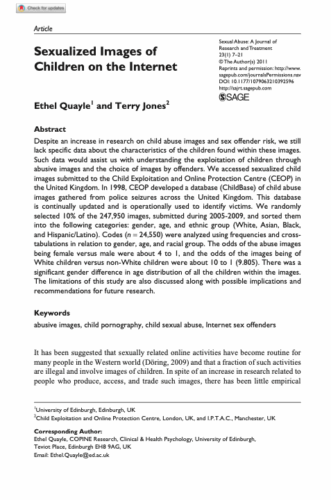Industry & Economics
Sexualized images of children on the Internet.
Open Access: No.
Abstract
Despite an increase in research on child abuse images and sex offender risk, we still lack specific data about the characteristics of the children found within these images. Such data would assist us with understanding the exploitation of children through abusive images and the choice of images by offenders. We accessed sexualized child images submitted to the Child Exploitation and Online Protection Centre (CEOP) in the United Kingdom. In 1998, CEOP developed a database (ChildBase) of child abuse images gathered from police seizures across the United Kingdom. This database is continually updated and is operationally used to identify victims. We randomly selected 10% of the 247,950 images, submitted during 2005-2009, and sorted them into the following categories: gender, age, and ethnic group (White, Asian, Black, and Hispanic/Latino). Codes (n = 24,550) were analyzed using frequencies and cross-tabulations in relation to gender, age, and racial group. The odds of the abuse images being female versus male were about 4 to 1, and the odds of the images being of White children versus non-White children were about 10 to 1 (9.805). There was a significant gender difference in age distribution of all the children within the images. The limitations of this study are also discussed along with possible implications and recommendations for future research.
Relevance
There was a significant difference between the number of female and male children within the images; the odds of the abuse images being female versus male were about 4 to 1, and the odds of the images being of White children versus non-White children were about 10 to 1.
Citation
Quayle, E., & Jones, T. (2011). Sexualized images of children on the Internet. Sexual abuse, 23(1), 7–21. https://doi.org/10.1177/1079063210392596

